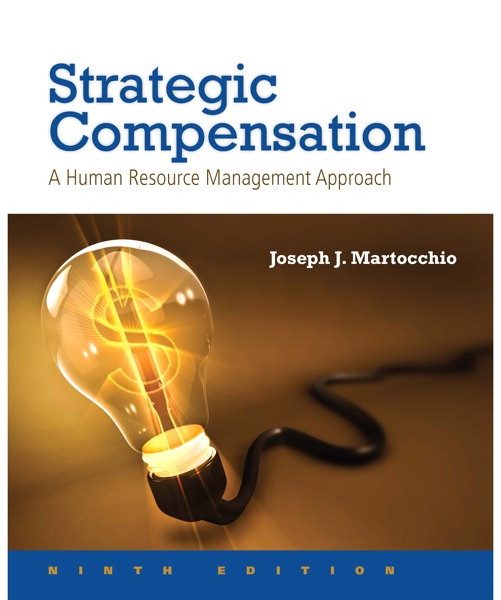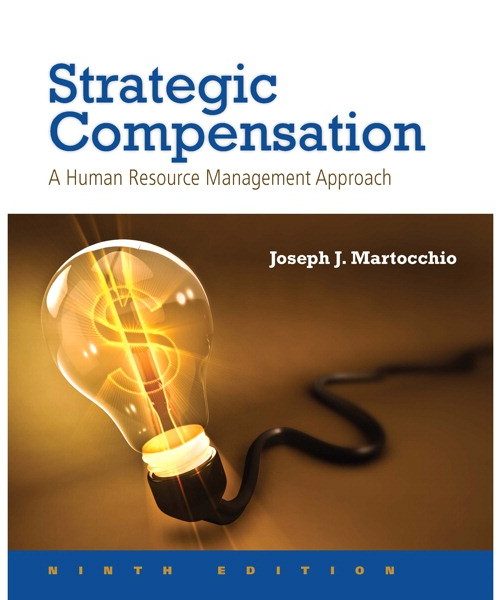This is completed downloadable of Test Bank for Strategic Compensation 9th Edition by Martocchio

Product Details:
- ISBN-10 : 0134320549
- ISBN-13 : 978-0134320540
- Author: Martocchio
Strategic Compensation: A Human Resource Management Approachdemonstrates the art and science of compensation practice and its role in a company’s competitive advantage. Through focused activities and supporting course material, readers build a solid foundation to become proficient compensation professionals.
The Ninth Edition focuses on the context of compensation practice, the criteria used to compensate employees, compensation system design issues, employee benefits, the challenges of compensating key strategic employee groups, and pay and benefits around the world, preparing readers to assume the roles of successful compensation professionals.
Table of Content:
- I Setting the Stage for Strategic Compensation
- 1 Strategic Compensation A Component of Human Resource Systems
- Learning Objectives
- Defining strategic Compensation
- What is Compensation?
- What Is Strategic Compensation?
- Compensation as A Strategic Business Partner
- Strategic Compensation Decisions
- Competitive Business Strategy Choices
- Lowest-Cost Strategy
- Differentiation Strategy
- Compensation Decisions that Support the Firm’s Strategy
- Employee Roles Associated with Competitive Strategies
- Building Blocks and Structure of Strategic Compensation Systems
- Building Blocks: Core Compensation and Employee Benefits
- Core Compensation
- Employee Benefits
- Fundamental Compensation System Design Elements
- Internal Consistency
- Market Competitiveness
- Recognizing Employee Contributions
- Alternative Pay Structure Configurations
- Fitting The Compensation Function in an Organization’s Structure
- How HR Professionals Fit into the Corporate Hierarchy
- The Compensation Profession
- How the Compensation Function Fits into HR Departments
- Compensation, Recruitment, and Selection
- Compensation and Performance Appraisal
- Compensation and Training
- Compensation and Career Development
- Compensation and Labor–Management Relations
- Compensation and Employment Termination
- Compensation and Legislation
- Stakeholders of the Compensation System
- Employees
- Line Managers
- Executives
- Unions
- U.S. Government
- End of Chapter Review
- Summary
- Key Terms
- MyManagementLab Chapter Quiz!
- Discussion Questions
- Case Competitive Strategy at Sportsman Shoes
- Questions:
- Crunch the Numbers! Calculating the Costs of Increasing the Total Compensation Budget at Butcher Enterprises
- Questions:
- Writing Assignments
- Endnotes
- 2 Contextual Influences on Compensation Practice
- Learning Objectives
- Interindustry Wage Differentials
- Pay Differentials Based on Occupational Characteristics
- Geographic Pay Differentials
- Labor Unions
- Employment Laws Pertinent to Compensation Practice
- Income Continuity, Safety, and Work Hours
- Fair Labor Standards Act of 1938
- Minimum Wage
- Overtime Provisions
- Child Labor Provisions
- Pay Discrimination
- Equal Pay Act of 1963
- Civil Rights Act of 1964
- Bennett Amendment
- Age Discrimination in Employment Act of 1967 (as Amended in 1978, 1986, and 1990)
- Civil Rights Act of 1991
- Accommodating Disabilities and Family Needs
- Pregnancy Discrimination Act of 1978
- Americans with Disabilities Act of 1990
- Family and Medical Leave Act of 1993
- Prevailing Wage Laws
- Davis–Bacon Act of 1931
- Walsh–Healey Public Contracts Act of 1936
- End of Chapter Review
- Summary
- Key Terms
- MyManagementLab Chapter Quiz!
- Discussion Questions
- Case Exempt or Nonexempt?
- Questions:
- Crunch the Numbers! Whether to Work Overtime or Hire Additional Employees
- Questions:
- Writing Assignments
- Endnotes
- II Bases for Pay
- 3 Traditional Bases for Pay Seniority and Merit
- Learning Objectives
- Seniority and Longevity Pay
- Historical Overview
- Who Participates?
- Effectiveness of Seniority Pay Systems
- Design of Seniority Pay and Longevity Pay Plans
- Advantages of Seniority Pay
- Fitting Seniority Pay with Competitive Strategies
- Merit Pay
- Who Participates?
- Exploring the Elements of Merit Pay
- Performance Appraisal
- Types of Performance Appraisal Plans
- Trait Systems
- Comparison Systems
- Behavioral Systems
- Goal-Oriented Systems
- Exploring the Performance Appraisal Process
- Four Activities to Promote Nondiscriminatory Performance Appraisal Practices
- Sources of Performance Appraisal Information
- Errors in the Performance Appraisal Process
- Bias Errors
- Contrast Errors
- Errors of Central Tendency
- Errors of Leniency or Strictness
- Strengthening The Pay-For-Performance Link
- Link Performance Appraisals to Business Goals
- Analyze Jobs
- Communicate
- Establish Effective Appraisals
- Empower Employees
- Differentiate among Performers
- Possible Limitations of Merit Pay Programs
- Failure to Differentiate among Performers
- Poor Performance Measures
- Supervisors’ Biased Ratings of Employee Job Performance
- Lack of Open Communication between Management and Employees
- Undesirable Social Structures
- Mounting Costs
- Factors Other than Merit
- Undesirable Competition
- Little Motivational Value
- End of Chapter Review
- Summary
- Key Terms
- MyManagementLab Chapter Quiz!
- Discussion Questions
- Case Appraising Performance at Precision
- Questions:
- Crunch the Numbers! Costs of Longevity and Merit Pay
- Questions:
- Writing Assignments
- Endnotes
- 4 Incentive Pay
- Learning Objectives
- Exploring Incentive Pay
- Contrasting Incentive Pay with Traditional Pay
- Individual Incentives
- Defining Individual Incentives
- Types of Individual Incentive Plans
- Piecework Plans
- Management Incentive Plans
- Behavioral Encouragement Plans
- Referral Plans
- spot bonuses
- Advantages of Individual Incentive Pay Programs
- Disadvantages of Individual Incentive Pay Programs
- Group Incentives
- Defining Group Incentives
- Types of Group Incentive Plans
- Team-Based or Small-Group Incentive Plans
- Gain Sharing Plans
- The Scanlon Plan
- The Rucker Plan
- Advantages of Group Incentives
- Disadvantages of Group Incentives
- Company-wide Incentives
- Defining Company-wide Incentives
- Types of Company-wide Incentive Plans
- Profit Sharing Plans
- Calculating Profit Sharing Awards
- Advantages of Profit Sharing Plans
- Disadvantages of Profit Sharing Plans
- Employee Stock Option Plans
- Designing Incentive Pay Programs
- Group versus Individual Incentives
- Level of Risk
- Complementing or Replacing Base Pay
- Performance Criteria
- Time Horizon: Short Term versus Long Term
- End of Chapter Review
- Summary
- Key Terms
- MyManagementLab Chapter Quiz!
- Discussion Questions
- Case Individual or Team Reward?
- Questions:
- Crunch the Numbers! Calculating Piecework Pay Awards
- Questions:
- Writing Assignments
- Endnotes
- 5 Person-Focused Pay
- Learning Objectives
- Defining Person-Focused Pay: Competency-Based, Pay-For-Knowledge, and Skill-Based Pay
- Usage of Person-Focused Pay Programs
- Reasons to Adopt Person-Focused Pay Programs
- Technological Innovation
- Increased Global Competition
- Varieties of Person-Focused Pay Programs
- Contrasting Person-Focused Pay With Job-Based Pay
- Advantages and Disadvantages of Person-Focused Pay Programs
- Advantages
- Disadvantages
- End of Chapter review
- MyManagementLab
- Summary
- Key Terms
- MyManagementLab Chapter Quiz!
- Discussion Questions
- Case Person-Focused Pay at Mitron Computers
- Questions:
- Crunch the Numbers! Training Budget Costs
- Questions:
- Writing Assignments
- Endnotes
- III Designing Compensation Systems
- 6 Building Internally Consistent Compensation Systems
- Learning Objectives
- Internal Consistency
- Job Analysis
- Steps in the Job Analysis Process
- Determine a Job Analysis Program
- Select and Train Analysts
- Direct Job Analyst Orientation
- Conduct the Study: Data Collection Methods and Sources of Data
- Summarize the Results: Writing Job Descriptions
- Legal Considerations for Job Analysis
- Job Analysis Techniques
- U.S. Department of Labor’s Occupational Information Network (O*NET)
- Experience Requirements
- Occupational Requirements
- Occupation-Specific Information RequirementS
- Workforce Characteristics
- Worker Characteristics
- Worker Requirements
- Using O*NET
- Job Evaluation
- Compensable Factors
- The Job Evaluation Process
- Determining Single versus Multiple Job Evaluation Techniques
- Choosing the Job Evaluation Committee
- Training Employees to Conduct Job Evaluations
- Documenting the Job Evaluation Plan
- Communicating with Employees
- Setting Up the Appeals Process
- Job Evaluation Techniques
- The Point Method
- Step 1: Select Benchmark Jobs
- Step 2: Choose Compensable Factors Based on Benchmark Jobs
- Step 3: Define Factor Degrees
- Step 4: Determine the Weight of Each Factor
- Step 5: Determine Point Values for Each Compensable Factor
- Step 6: Verify Factor Degrees and Point Values
- Step 7: Evaluate All Jobs
- Balancing Internal and Market Considerations Using the Point Method
- Alternative Job-Content Evaluation Approaches
- Simple Ranking Plans
- Paired Comparison and Alternation Ranking
- Classification Plans
- Alternatives to Job Evaluation
- Internally Consistent Compensation Systems and Competitive Strategy
- End of Chapter Review
- Summary
- Key Terms
- MyManagementLab Chapter Quiz!
- Discussion Questions
- Case Internal Consistency at Customers First
- Questions:
- Crunch the Numbers! Modifying a Job Evaluation Worksheet
- Writing Assignments
- Endnotes
- 7 Building Market-Competitive Compensation Systems
- Learning Objectives
- Market-Competitive Pay Systems: The Basic Building Blocks
- Compensation Surveys
- Preliminary Considerations
- What Companies Hope to Gain from Compensation Surveys
- Custom Development versus Use of an Existing Compensation Survey
- Using Published Compensation Survey Data
- Survey Focus: Core Compensation or Employee Benefits
- Sources of Published Compensation Surveys
- Employment Cost Trends
- National Compensation Data
- Wages By Area and Occupation
- Earnings By Demographics
- Earnings By Industry
- County Wages (Quarterly Census of Employment and Wages)
- Employee Benefits National Compensation Survey
- Compensation Costs in Other Countries
- Compensation Surveys: Strategic Considerations
- Defining the Relevant Labor Market
- Choosing Benchmark Jobs
- Compensation Survey Data
- Using the Appropriate Statistics to Summarize Survey Data
- Updating the Survey Data
- Integrating Internal Job Structures with External Market Pay Rates
- Compensation Policies and Strategic Mandates
- Pay Level Policies
- Pay Mix Policies
- End of Chapter Review
- Summary
- Key Terms
- MyManagementLab Chapter Quiz!
- Discussion Questions
- Case Nutriment’s New Hires
- Questions:
- Crunch the Numbers! Updating Salary Survey Data
- Questions:
- Writing Assignments
- Endnotes
- 8 Building Pay Structures That Recognize Employee Contributions
- Learning Objectives
- Constructing a Pay Structure
- Step 1: Deciding on the Number of Pay Structures
- Exempt And Nonexempt Pay Structures
- Pay Structures Based on Job Family
- Pay Structures Based On Geography
- Step 2: Determining a Market Pay Line
- Step 3: Defining Pay Grades
- Step 4: Calculating Pay Ranges for Each Pay Grade
- Pay Compression
- Green Circle Pay Rates
- Red Circle Pay Rates
- Step 5: Evaluating the Results
- Designing Merit Pay Systems
- Merit Increase Amounts
- Timing
- Recurring versus Nonrecurring Merit Pay Increases
- Present Level of Base Pay
- Rewarding Performance: The Merit Pay Grid
- Employees’ Performance Ratings
- Employees’ Positions within the Pay Range
- Merit Pay Increase Budgets
- Designing Sales Incentive Compensation Plans
- Alternative Sales Compensation Plans
- Salary-Only Plans
- Salary-Plus-Bonus Plans
- Salary-Plus-Commission Plans
- Commission-Plus-Draw Plans
- Commission-Only Plans
- Sales Compensation Plans and Competitive Strategy
- Determining Fixed Pay and the Compensation Mix
- Influence of The Salesperson on the Buying Decision
- Competitive Pay Standards within the Industry
- Amount of Nonsales Activities Required
- Designing Person-Focused Programs
- Establishing Skill Blocks
- Transition Matters
- Skills Assessment
- Aligning Pay with the Knowledge Structure
- Access to Training
- Training and Certification
- In-House or Outsourcing Training
- Certification and Recertification
- Pay Structure Variations
- Broadbanding
- The Broadbanding Concept And Its Advantages
- Limitations of Broadbanding
- Two-Tier Pay Structures
- The Two-Tier Pay System Concept and Its Advantages
- Limitations of Two-Tier Pay Structures
- End of Chapter Review
- Summary
- Key Terms
- MyManagementLab Chapter Quiz!
- Discussion Questions
- Case A New Sales Representative
- Questions:
- Crunch the Numbers! Calculating Pay Range Minimums, Maximums, and Pay Range Overlap
- Questions:
- Writing Assignments
- Endnotes
- IV Employee Benefits
- 9 Discretionary Benefits
- Learning Objectives
- Origins of Discretionary Benefits
- Categories of Discretionary Benefits
- Protection Programs
- Disability Insurance
- Life Insurance
- Retirement Programs
- Paid Time Off
- Services
- Employee Assistance Programs
- Family Assistance Programs
- Tuition Reimbursement
- Transportation Services
- Outplacement Assistance
- Wellness Programs
- Financial Education
- Legislation Pertinent To Discretionary Benefits
- Internal Revenue Code
- Employee Retirement Income Security Act of 1974 (ERISA)
- Pension Protection Act of 2006
- Defined Benefit Plans
- Defined Contribution Plans
- Designing and Planning the Benefits Program
- Determining Who Receives Coverage
- Financing
- Employee Choice
- Cost Containment
- Communication
- The Benefits and Costs of Discretionary Benefits
- End of Chapter Review
- Summary
- Key Terms
- MyManagementLab
- Discussion Questions
- Case Time Off At Superior Software Services
- Questions:
- Crunch the Numbers! 401(k) Plan Contributions: Allowable Amounts and Employer Match
- Questions:
- Writing Assignments
- Endnotes
- 10 Legally Required Benefits
- Learning Objectives
- Origins of Legally Required Benefits
- Categories of Legally Required Benefits
- Social Security Programs
- Unemployment Insurance
- Old Age, Survivor, and Disability Insurance
- Old Age Benefits
- Survivor Benefits
- Disability Benefits
- Medicare
- Medicare Part A Coverage
- Medicare Part B Coverage
- Medigap Insurance
- Medicare Part C Coverage—medicare advantage
- Medicare Prescription Drug Benefit
- Financing OASDI and Medicare Programs
- OASDI Programs
- Medicare Programs
- Workers’ Compensation
- Workers’ Compensation Objectives and Obligations to the Public
- How Workers’ Compensation Compares to Social Security Benefits
- Recent Trends in Workers’ Compensation
- Financing Workers’ Compensation Programs
- Family and Medical Leave
- Health Insurance
- Health Insurance Program design alternatives
- Fee-For-Service Plans
- Deductible
- Coinsurance
- Out-of-Pocket Maximum
- Preexisting Condition Clauses
- Maximum Benefit Limits
- Managed Care Approach
- Health Maintenance Organizations
- Primary Care Physicians
- Copayments
- Preferred Provider Organizations
- Deductibles
- Coinsurance
- Point-Of-Service Plans
- Specialized Insurance Benefits
- Prescription Drug Plans
- Mental Health And Substance Abuse
- Consumer-Driven Health Care
- Additional Health Care Legislation
- Consolidated Omnibus Budget Reconciliation Act of 1985 (COBRA)
- Health Insurance Portability and Accountability Act of 1996 (HIPAA)
- The benefits and costs of Legally Required Benefits
- End of Chapter REVIEW
- Summary
- Key Terms
- MyManagementLab Chapter Quiz!
- Discussion Questions
- Case A Health Savings Account at Frontline PR
- Questions:
- Crunch the Numbers! Calculating Taxes under the Patient Protection and Affordable Care Act
- Questions:
- Writing Assignments
- Endnotes
- V Contemporary Strategic Compensation Challenges
- 11 Compensating Executives
- Learning Objectives
- Contrasting Executive Pay with Pay for Nonexecutive Employees
- Defining Executive Status
- Who Are Executives?
- Key Employees
- Highly Compensated Employees
- Executive Compensation Packages
- Components of Current Core Compensation
- Base Pay
- Bonuses
- Short-Term Incentives
- Components of Deferred Core Compensation
- Equity Agreements
- Stock Options
- Restricted STOCK PLANS, Restricted Stock Units, and Performance Stock Awards
- Stock Appreciation Rights
- Phantom Stock Plans
- Employee Stock Purchase Plans
- Separation Agreements
- Golden Parachutes
- Platinum Parachutes
- Clawback Provisions
- Employee Benefits: Enhanced Protection Program Benefits and Perquisites
- Enhanced Protection Program Benefits
- Perquisites
- Principles and Processes for Setting Executive Compensation
- The Key Players in Setting Executive Compensation
- Executive Compensation Consultants
- Board of Directors
- Compensation Committee
- Theoretical Explanations for Setting Executive Compensation
- Agency Theory
- Tournament Theory
- Social Comparison Theory
- Executive Compensation Disclosure Rules
- Securities and Exchange Act of 1934
- Wall Street Reform and Consumer Protection Act of 2010 (Dodd-Frank Act)
- Executive Compensation: Are U.S. Executives Paid Too Much?
- Comparison between Executive Compensation and Compensation for Other Worker Groups
- Strategic Questions: Is Pay for Performance?
- Ethical Considerations: Is Executive Compensation Fair?
- Attract and Retain Top Executives
- Income Disparities
- Layoffs Borne by Workers but Not Executives
- International Competitiveness
- International Compensation Comparisons
- Undermining U.S. Companies’ Ability to Compete
- End of Chapter Review
- Summary
- Key Terms
- MyManagementLab Chapter Quiz!
- Discussion Questions
- Case CEO Pay in the News
- Questions:
- Crunch the Numbers! Comparison of Pay within and Across Industries
- Questions:
- Writing Assignments
- Endnotes
- 12 Compensating the Flexible Workforce Contingent Employees and Flexible Work Schedules
- Learning Objectives
- The Contingent Workforce
- Groups of Contingent Workers
- Part-Time Employees
- Temporary And On-Call Employees
- Leased Employee Arrangements
- Independent Contractors, Freelancers, and Consultants
- Reasons for U.S. Employers’ Increased Reliance on Contingent Workers
- Economic Recessions
- International Competition
- The Shift From Manufacturing to a Service Economy
- Pay and Employee Benefits for Contingent Workers
- Part-Time Employees
- Pay
- Employee Benefits
- Temporary Employees
- Pay
- Employee Benefits
- Leased Workers
- Pay
- Employee Benefits
- Independent Contractors, Freelancers, and Consultants
- Common-Law Test
- Economic Realities Test
- Flexible Work Schedules: Flextime, Compressed Workweeks, And Telecommuting
- Watch It!
- Flextime Schedules
- Compressed Workweek Schedules
- Telecommuting
- Flexible Work Schedules: Balancing the Demands of Work Life and Home Life
- Pay and Employee Benefits for Flexible Employees
- Pay
- Employee Benefits
- Unions’ Reactions to Contingent Workers and Flexible Work Schedules
- Strategic Issues and Choices In Using Contingent and Flexible Workers
- End of Chapter Review
- MyManagementLab
- Summary
- Key Terms
- MyManagementLab Chapter Quiz!
- Discussion Questions
- Case Telecommuting at MedEx
- Questions:
- Crunch the Numbers! Calculating the Costs of Full-Time and Part-Time Employment
- Questions:
- Writing Assignments
- Endnotes
- VI Compensation Issues around the World
- 13 Compensating Expatriates
- Learning Objectives
- Competitive Advantage and how International Activities Fit In
- Lowest-Cost Producers’ Relocations to Cheaper Production Areas
- Differentiation and the Search for New Global Markets
- How Globalization Is Affecting HR Departments
- Complexity of International Compensation Programs
- Preliminary Considerations
- Host Country Nationals, Third Country Nationals, and Expatriates: Definitions and Relevance for Compensation Issues
- Term of International Assignment
- Staff Mobility
- Equity: Pay Referent Groups
- Components of International Compensation Programs
- Setting Base Pay for U.S. Expatriates
- Methods for Setting Base Pay
- Home Country-Based Method
- Host Country-Based Method
- Headquarters-Based Method
- Purchasing Power
- Currency Stabilization
- Inflation
- Incentive Compensation for U.S. Expatriates
- Foreign Service Premiums
- Hardship Allowances
- Mobility Premiums
- Establishing Employee Benefits for U.S. Expatriates
- Standard Benefits for U.S. Expatriates
- Protection Programs
- Paid Time Off
- Enhanced Benefits for U.S. Expatriates
- Relocation Assistance
- Education Reimbursements for Expatriates’ Children
- Home Leave Benefits and Travel Reimbursements
- Rest and Relaxation Leave and Allowance
- Balance Sheet Approach for U.S. Expatriates’ Compensation Packages
- Housing and Utilities
- Goods and Services
- Discretionary Income
- Tax Considerations
- Employer Considerations: Tax Protection and Tax Equalization
- Repatriation Pay Issues
- End of Chapter Review
- Summary
- Key Terms
- MyManagementLab Chapter Quiz!
- Discussion Questions
- Case Jenkins Goes Abroad
- Questions:
- Crunch the Numbers! Calculating an Expatriate’s Base Pay and Incentives
- Questions:
- Writing Assignments
- Endnotes
- 14 Pay and Benefits Outside the United States
- Learning Objectives
- Pertinent Concepts for Quantifying Economic Elements in the Discussion of Pay and Benefits Outside the United States
- North America
- Canada
- Wage and Salary6
- Paid Time Off Benefits
- Protection Benefits
- Pensions and Retirement Benefits
- Health and Disability Benefits
- Mexico
- Wage and Salary
- Paid Time Off Benefits
- Protection Benefits
- Social Security
- Pensions and Retirement Benefits
- Health Benefits
- Other Benefits
- South America
- Brazil
- Wage and Salary
- Protection Benefits
- Social Security
- Pensions
- Health Benefits
- Europe
- Germany
- Wage and Salary
- Paid Time Off Benefits37
- Protection Benefits
- Pensions38
- Health Insurance
- Asia
- India
- Wage and Salary.
- Paid Time Off Benefits47
- Protection Benefits
- Pensions48
- Health Benefits
- People’s Republic of China
- Wage and Salary
- Paid Time Off Benefits55
- Protection Benefits
- Pensions
- Health Insurance57
- End of Chapter Review
- Summary
- Key Terms
- MyManagementLab Chapter Quiz!
- Discussion Questions
- Case North American Expansion for Threads Apparel
- Questions:
- Crunch the Numbers! Comparing the Rates of Change in GDP Per Capita for Select Countries
- Questions:
- Writing Assignments
- Endnotes
- Epilogue
- 15 Challenges Facing Compensation Professionals
- Learning Objectives
- Possible Increase to the Federal Minimum Wage Rate and Strengthening Overtime Pay Protections
- Raising the Minimum Wage
- Strengthening Overtime Pay Protections
- Rising Wages in China
- Underemployment and the Compensation-Productivity Gap
- Underemployment
- The Compensation–Productivity Gap
- Workforce Demographic Shifts
- Labor Force Diversity
- Relevance for Employee Benefits
- End of Chapter review
- Summary
- Key Terms
- MyManagementLab Chapter Quiz!
- Discussion Questions
- Case Benefits for Part-Time Workers
- Questions:
- Crunch the Numbers! Calculating Regional and Industry Pay Differences in China
- Writing Assignments
- Endnotes
- Glossary
- Author Index
- A
- B
- C
- D
- E
- F
- G
- H
- I
- J
- K
- L
- M
- N
- O
- P
- R
- S
- T
- U
- V
- W
- X
- Y
- Z
- Subject Index
- A
- B
- C
- D
- E
- F
- G
- H
- I
- J
- K
- L
- M
- N
- O
- P
- Q
- R
- S
- T
- U
- V
- W
- X
- Y





